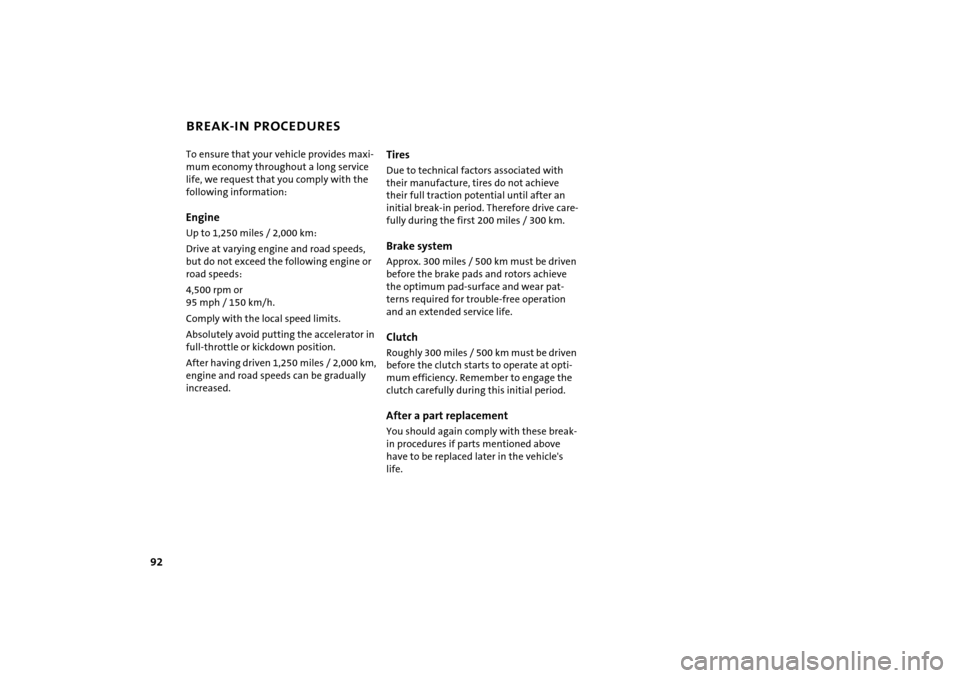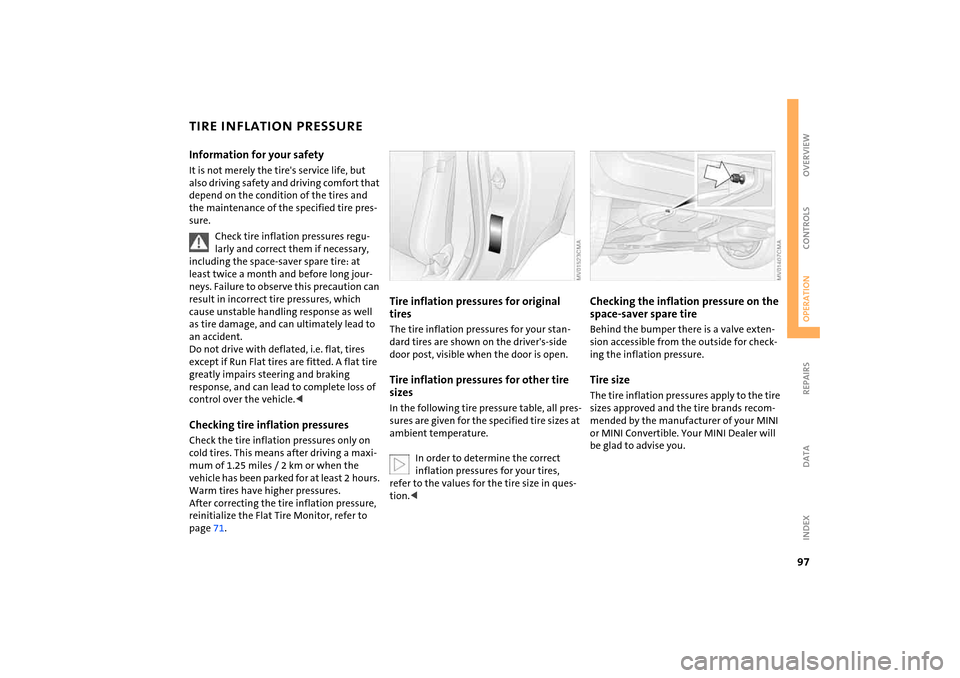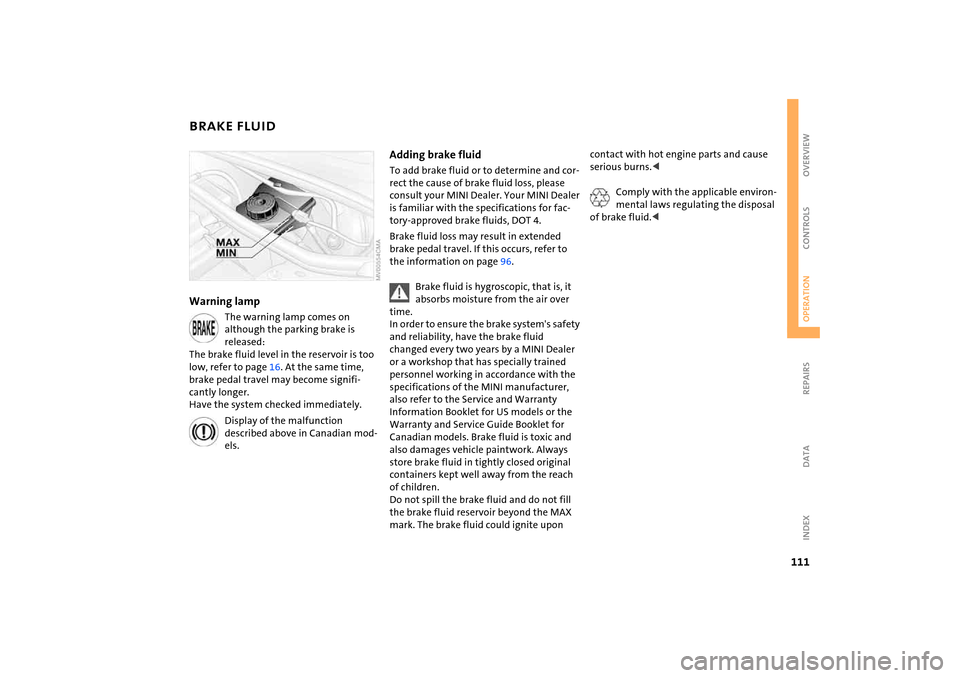service MINI Hardtop 2 Door 2005 User Guide
[x] Cancel search | Manufacturer: MINI, Model Year: 2005, Model line: Hardtop 2 Door, Model: MINI Hardtop 2 Door 2005Pages: 165, PDF Size: 2.32 MB
Page 71 of 165

69
OVERVIEW REPAIRS OPERATIONCONTROLS DATA INDEX
DYNAMIC STABILITY CONTROL (DSC)
*
The conceptThis system optimizes driving stability and
traction, especially when just starting off,
when accelerating or when cornering. It
also maintains driving stability even in crit
-
ical driving situations.DSC recognizes unstable vehicle conditions,
such as understeering or oversteering, and,
as far as is possible within the laws of phys
-
ics, helps keep the vehicle on a steady
course by reducing the rpms and by brake
applications to the individual wheels.The DSC is operational every time you start
the engine. It contains the following func
-
tions:>All Season traction Control (ASC)>Antilock Brake System (ABS)>Cornering Brake Control (CBC)>Electronic Brake Force Distribution (EBD).
The laws of physics cannot be repealed, even with DSC. An appro
-
priate driving style always remains the
responsibility of the driver. Avoid using the
additional safety margin provided by the
system as an excuse for taking unnecessary
risks.
Do not make any modifications to the DSC
system. Allow only authorized technicians
to perform service procedures on the
DSC.
switched on, refer to pages
17, 18
.
If the indicator lamp flashes:
DSC controls the drive and braking forces. The indicator lamp stays lit:
The system is defective or was turned off
using the button. Have the system checked
as soon as possible.
To switch off the DSCBriefly press the switch.
The indicator lamp stays lit.When driving with snow chains, it may be
effective to switch off the DSC for a brief
period.
To maintain stability, always drive with the DSC switched on whenever
possible.<
To switch the DSC back onBriefly press the switch once again.
Indicator lamp goes out.
Page 75 of 165

73
OVERVIEW REPAIRS OPERATIONCONTROLS DATA INDEX
AIRBAGSProtective effectThe front airbags supplement the safety
belts by providing additional protection for
the driver and front passenger in the event
of a frontal collision in which the protec
-
tion afforded by the belts alone may no
longer be sufficient. When needed, the
head and side airbags help to furnish pro
-
tection in the event of side impact. Each of
the side airbags is designed to help support
the seat occupant's upper body. The corre
-
sponding side/head airbag in the MINI Con
-
vertible or the head airbag in the MINI sup
-
ports the head.The airbags are designed to not be trig
-
gered in certain types of collisions, e.g. in
minor accidents, certain kinds of vehicle
rollover and rear impact.For information on the ideal seating posi
-
tion, refer to page
41.
Do not apply adhesive materials to the cover panels of the airbags, cover
them or modify them in any other way. Do
not fit covers, cushions or other items to
the front seats that have not been specially
approved for seats with side airbags. Do
not hang clothing, e.
g. jackets, over the
backrests.
Do not attempt to remove the airbag
restraint system from the vehicle. Do not
touch the individual components directly
after the system has been triggered, as oth
-
erwise there is a danger of burns. In the
event of malfunctions, deactivation or
deployment of the airbag restraint system,
have the system checked, repaired or disas
-
sembled only by a MINI Dealer or a work
-
shop with specially trained personnel work
-
ing in accordance with the specifications of
the MINI manufacturer and having the nec
-
essary permits for handling explosive
devices. Unprofessional attempts to service
the system could lead to failure in an emer
-
gency or undesired airbag activation, either
of which could result in personal injury.
vided on the sun visors.Airbag system operational
The warning lamp in the display elements shows the status of the
entire airbag system and the seat
belt tensioners starting from ignition key
position 1. The warning lamp goes out after
several seconds.
Airbag system malfunctioning >The warning lamp does not come on
starting from ignition key position
1
>The warning lamp stays lit>The warning lamp lights up while driv
-
ing.
In the event of a malfunction, have the airbag system checked immedi
-
ately. Otherwise, there is a risk that the sys
-
tem will not function as intended in
response to a severe impact occurring
within the system's normal triggering
range.<
Page 93 of 165

OVERVIEW
CONTROLS
OPERATION, CARE, MAINTENANCE
OWNER SERVICE PROCEDURES
INDEX TECHNICAL DATA
91
OVERVIEW REPAIRSOPERATIONCONTROLS DATA INDEX
Operation
Page 94 of 165

92
BREAK-IN PROCEDURES To ensure that your vehicle provides maxi
-
mum economy throughout a long service
life, we request that you comply with the
following information: EngineUp to 1,250
miles
/ 2,000
km:
Drive at varying engine and road speeds,
but do not exceed the following engine or
road speeds:4,500
rpm or
95 mph
/ 150
km/h.
Comply with the local speed limits.Absolutely avoid putting the accelerator in
full-throttle or kickdown position.After having driven 1,250
miles
/ 2,000
km,
engine and road speeds can be gradually
increased.
TiresDue to technical factors associated with
their manufacture, tires do not achieve
their full traction potential until after an
initial break-in period. Therefore drive care
-
fully during the first 200
miles
/ 300
km.
Brake systemApprox. 300
miles
/ 500
km must be driven
before the brake pads and rotors achieve
the optimum pad-surface and wear pat
-
terns required for trouble-free operation
and an extended service life.ClutchRoughly 300
miles
/ 500
km must be driven
before the clutch starts to operate at opti
-
mum efficiency. Remember to engage the
clutch carefully during this initial period.After a part replacementYou should again comply with these break-
in procedures if parts mentioned above
have to be replaced later in the vehicle's
life.
Page 96 of 165

94
REFUELING
Always switch off the engine before refueling. If you do not, fuel cannot
be filled into the tank and the SERVICE
ENGINE SOON lamp may come on.<
1. Open the fuel filler door2. Turn the gas cap counterclockwise3. Put the gas cap in the bracket attached
to the fuel filler door.
Always observe all applicable precau
-
tions and regulations when handling
fuels. Never carry spare fuel containers in
your vehicle. Whether empty or full, these
containers can leak, cause an explosion,
and lead to fire in the event of a collision.<
Observe the following when refueling
Always observe all safety precautions posted at the service station when
handling fuel.<
When refueling, insert the filler nozzle
completely into the filler pipe. Pulling the
nozzle out of the pipe during refueling:>Results in premature pump shutoff>Will reduce the effect of the fuel vapor
recovery system on the pump.As long as the filler nozzle is used properly,
the fuel tank is full whenever the nozzle
shuts off the first time.Closing the gas cap1. Put on gas cap 2. Turn gas cap clockwise until it clicks3. Close fuel filler door.
Close the gas cap carefully after
refuelling until a click is heard.
While closing, be sure not to squeeze the
strap which is fastened to the cap.<
US models only:
The warning lamp
* comes on.
The gas cap is not correctly closed
or missing. Check if the gas cap is
correctly closed.
Fuel tank volumeApprox. 13.2
gallons
/ 50
liters, of which
approx. 2.1
gallons
/ 8
liters are reserve
capacity.
Do not drive until the fuel tank is totally empty. Otherwise engine
operations are not guaranteed and damage
could occur.<
Fuel specification The engine uses lead-free gasoline only.Required fuel Premium Unleaded Gasoline,
Minimum Octane Rating: 91.Minimum Octane Rating corresponds to
the Anti Knock Index (AKI) and is deter
-
mined according to the so-called (R+M)/2
method.
Page 99 of 165

97
OVERVIEW REPAIRSOPERATIONCONTROLS DATA INDEX
TIRE INFLATION PRESSURE Information for your safetyIt is not merely the tire's service life, but
also driving safety and driving comfort that
depend on the condition of the tires and
the maintenance of the specified tire pres
-
sure.
Check tire inflation pressures regu
-
larly and correct them if necessary,
including the space-saver spare tire: at
least twice a month and before long jour
-
neys. Failure to observe this precaution can
result in incorrect tire pressures, which
cause unstable handling response as well
as tire damage, and can ultimately lead to
an accident.
Do not drive with deflated, i.e. flat, tires
except if Run Flat tires are fitted. A flat tire
greatly impairs steering and braking
response, and can lead to complete loss of
control over the vehicle.
-
mum of 1.25
miles / 2
km or when the
vehicle has been parked for at least 2
hours.
Warm tires have higher pressures.
After correcting the tire inflation pressure,
reinitialize the Flat Tire Monitor, refer to
page
71.
Tire inflation pressures for original tiresThe tire inflation pressures for your stan
-
dard tires are shown on the driver's-side
door post, visible when the door is open.Tire inflation pressures for other tire
sizesIn the following tire pressure table, all pres
-
sures are given for the specified tire sizes at
ambient temperature.
In order to determine the correct inflation pressures for your tires,
refer to the values for the tire size in ques
-
tion.<
Checking the inflation pressure on the space-saver spare tireBehind the bumper there is a valve exten
-
sion accessible from the outside for check
-
ing the inflation pressure.Tire sizeThe tire inflation pressures apply to the tire
sizes approved and the tire brands recom
-
mended by the manufacturer of your MINI
or MINI Convertible. Your MINI Dealer will
be glad to advise you.
Page 101 of 165

99
OVERVIEW REPAIRSOPERATIONCONTROLS DATA INDEX
TIRE CODINGKnowing the tire code on the tire's sidewall
makes it easier for you to choose and iden
-
tify the correct tires.Tire sizee.g. 205/45
R 17 84 V
Nominal width in mm Cross-sectional
ratio in % Radial belt construction Rim diameter in inches Load index,
not on ZR tiresSpeed code letter,
in front of the R on ZR tiresSpeed code letters:Q = up to 100 mph / 160
km/h
T= up to 118
mph
/ 190
km/h
H= up to 131
mph
/ 210
km/h
V= up to 150
mph
/ 240
km/h
W= up to 167
mph
/ 270
km/h
Tire Identification NumberTires with DOT codes meet the guidelines
of the U.S. Department of Transportation.
DOT code:e.g. DOT xxxx xxx 2704Manufacturer's code
for tire make Tire size and
tire version Tire age Tire ageThe date on which the tire was manufac
-
tured is indicated by the code on the side
-
wall:
DOT...2704 indicates that the tire was man
-
ufactured in Week 27 of the year 2004.The manufacturer of your vehicle recom
-
mends replacing all tires after 6
years at
the latest, even if a tire service life of
10
years is possible.
Uniform Tire Quality GradingQuality grades can be found where applica
-
ble on the tire sidewall between tread
shoulder and maximum section width.
For example:Treadwear 200 Traction AATemperature A
DOT quality gradesTread wear Traction AA A B C Temperature A B C
All passenger car tires must conform to Federal Safety Requirements in
addition to these grades.<
Tread wearThe tread wear grade is a comparative rat
-
ing based on the wear rate of the tire when
tested under controlled conditions on a
specified government test course.
For example, a tire graded 150 would wear
one and one-half, 1
γ, times as well on the
government course as a tire graded 100.
The relative performance of tires depends
upon the actual conditions of their use,
however, and may depart significantly
from the norm due to variations in driving
habits, service practices and differences in
road characteristics and climate.
Page 107 of 165

105
OVERVIEW REPAIRSOPERATIONCONTROLS DATA INDEX
BONNET
Do not attempt to service your vehi
-
cle if you do not have the required
technical background. If you are not famil
-
iar with the regulations to be observed,
have the necessary work on your vehicle
carried out only by a MINI Dealer or a work
-
shop that has specially trained personnel
working in accordance with the specifica
-
tions of the MINI manufacturer.
Work that is improperly carried out could
result in consequential damage and pose
safety hazards.<
To unlockPull the lever in the right door area beneath
the instrument panel.
To open1. Reach under the bonnet2. Pull the release lever3. Open the bonnet.To closeAllow the bonnet to fall from a height of
approx.
1 ft / 30
cm.
To avoid injuries, as with all closing procedures be sure that the travel
path of the bonnet is clear when it is closed.
If it is determined that the bonnet is not
completely closed while driving, stop
immediately and close it securely, also refer
to page
17.<
Page 111 of 165

109
OVERVIEW REPAIRSOPERATIONCONTROLS DATA INDEX
ENGINE OILAdding engine oil
Only top up oil when the oil level has dropped to just above the lower
notch of the dipstick. However, never allow
the level to drop below the lower notch.
tives could lead to damage in some cases.
Continuous exposure to used oil has
caused cancer in laboratory testing.
For this reason, any skin areas that come
into contact with oil should be thoroughly
washed with soap and water.
Always store oil, grease, etc., out of reach of
children. Comply with all warning labels
and information on lubricant containers.<
Comply with the applicable environ
-
mental laws regulating the disposal
of used oil.<
Specified engine oilsThe quality of the engine oil selected has
critical significance for the operation and
service life of an engine. Based on exten
-
sive testing, the manufacturer of your MINI
approves only certain grades of engine oil. Use only approved MINI High Performance
Synthetic Oil.If you are unable to obtain MINI High Per
-
formance Synthetic Oil, you can add small
amounts of synthetic oil in between oil
changes. Only use oils with the API SH spec
-
ification or higher.
Ask your authorized MINI Dealer for details concerning the specific MINI
High Performance Synthetic Oil or syn
-
thetic oils which have been approved.<
Viscosities Viscosity is the oilflow rating as established
in SAE classes.The choice of the proper SAE class depends
on the climatic conditions in the area
where your MINI is used.
Approved oils are in SAE classes 5W-40 and 5W-30.<
These oils can be used at all ambient tem
-
peratures.
Page 113 of 165

111
OVERVIEW REPAIRSOPERATIONCONTROLS DATA INDEX
BRAKE FLUIDWarning lamp
The warning lamp comes on although the parking brake is
released:
The brake fluid level in the reservoir is too
low, refer to page
16. At the same time,
brake pedal travel may become signifi
-
cantly longer.
Have the system checked immediately.
Display of the malfunction described above in Canadian mod
-
els.
Adding brake fluid To add brake fluid or to determine and cor
-
rect the cause of brake fluid loss, please
consult your MINI Dealer. Your MINI Dealer
is familiar with the specifications for fac
-
tory-approved brake fluids,
DOT
4.
Brake fluid loss may result in extended
brake pedal travel. If this occurs, refer to
the information on page
96.
Brake fluid is hygroscopic, that is, it absorbs moisture from the air over
time.
In order to ensure the brake system's safety
and reliability, have the brake fluid
changed every two years by a MINI Dealer
or a workshop that has specially trained
personnel working in accordance with the
specifications of the MINI manufacturer,
also refer to the Service and Warranty
Information Booklet for US
models or the
Warranty and Service Guide Booklet for
Canadian models. Brake fluid is toxic and
also damages vehicle paintwork. Always
store brake fluid in tightly closed original
containers kept well away from the reach
of children.
Do not spill the brake fluid and do not fill
the brake fluid reservoir beyond the MAX
mark. The brake fluid could ignite upon
contact with hot engine parts and cause
serious burns.<
Comply with the applicable environ
-
mental laws regulating the disposal
of brake fluid.<